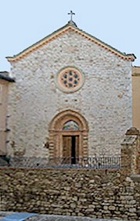Studio e Fornace Angeletti-Biscarini
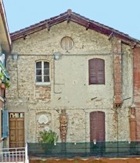
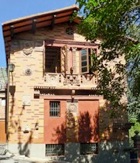
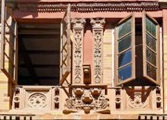
Facade at number 16 Facade at number 22 Detail of latter
Raffaele Angeletti and Francesco Biscarini (below) established a sculpture studio here in 1861 and a furnace for producing architectural terracottas in 1870. The latter were extremely fashionable in the 19th century. The establishment closed in 1899, following the death of Raffaele Angeletti. Angelo Biscarini (below), Francesco’s nephew, reopened it in 1914 and continued to operate it until his death in 1951.
The building that housed the studio and furnace, which survive in Via del Cantorino (see Walk IV), has two facades that were decorated with some of the architectural terracottas that were produced here:
-
✴one is down the steps ahead of you, at number 16; and
-
✴the other, at number 22 (illustrated here), is further along Via Cantorino: go up the steps again and follow the road round to the left, along the garden hedge.
Francesco Biscarini (1838-1903)
Francesco Biscarini studied at the Accademia di Belle Arti, where he formed friendships with Raffaele Angeletti and Guglielmo Calderini. He formed the Studio e Fornace Angeletti-Biscarini (above) with the former in 1861-70.
Palazzo Calderini (1871)
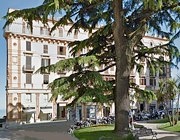
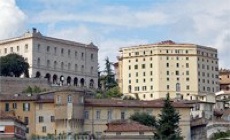
Facade in Piazza d’ Italia Semi-circular back of the palace, with
Palazzo della Provincia to the left
and Palazzo della Penna below
Guglielmo Calderini built Palazzo Calderini on the semi-circular foundations established by Cardinal Rivarola in his remodelling of what was then Piazza Rivarola in 1800-8. The palace was the first condominium in Perugia. The terracotta reliefs on the facade came from the Fornace Angeletti-Biscarini.
San Costanzo (1882-90)
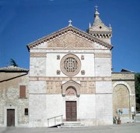
Palazzo Cesaroni (1897)
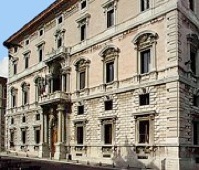
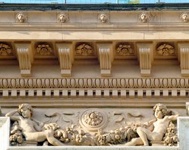
Palazzo Cesaroni was built for Ferdinando Cesaroni by Guglielmo Calderini. Houses on this site that had belonged to the Monaldi family had been demolished in ca. 1540 to make way for Rocca Paolina. The palace was never occupied by the Cesaroni family. It served as the Palace Hotel until 1925, when it was bought by an insurance company. It passed to the state in the 1970s and now houses the Consiglio Regionale dell' Umbria.
The terracotta frieze of putti under the cornice under the roof came from Fornace Angeletti-Biscarini.
Biscarini Monument (1874)
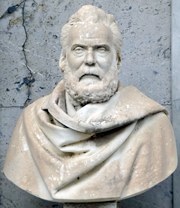
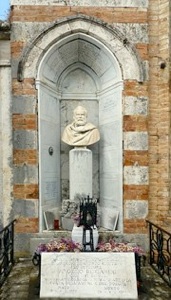
Bust (1874) of Angelo Biscarini Senior Biscarini Monument
The monument to Angelo Biscarini senior, the father of Francesco Biscarini, was erected at the far left-hand corner of the Cimitero Civico (cemetery) on his death in 1874. He is commemorated on the column that supports his bust.
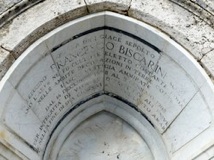
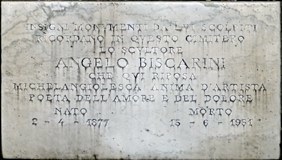
Inscription (1903) to Francesco Biscarini Inscription (1951) to Angelo Biscarini
Other inscriptions commemorate:
-
✴Francesco Biscarini (above); and
-
✴his nephew, Angelo Biscarini (below).
Tombs from Studio Angeletti - Biscarini (late 19th century)

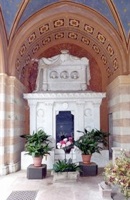
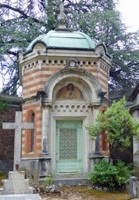
Tomba Fioretti (1868) Tomba Angelini-Paroli (1883) Cappella Fani (1892)

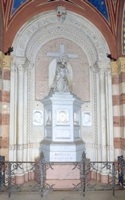

Tomba Nottari (1888) Tomba Rizzoli-Ticchioni (1893) Tomba Paolo Angeloni (1897)
The monuments in the Cimitero Civico (cemetery) commissioned from the studio in the late 19th century are described in a guide to the cemetery referenced on the page devoted to it. They included the six illustrated above.
Nazareno Biscarini (1835-1907)
Like his brother, Nazareno Biscarini studied at the Accademia di Belle Arti. He became an architect and engineer, and lectured at the academy from 1884.
His joint proposal with Americo Calderini for the design of the new Palazzo del Governo (now the Palazzo della Provincia e Prefettura) in 1863 was well-received. However, the “outsider” Alessandro Arienti was appointed as civic architect in 1865 and his design for the palace was approved two years later. (Nazareno Biscarini and Americo Calderini published a critical report on this decision, but to no avail).
Cappella della Confraternita della Misericordia (1888)
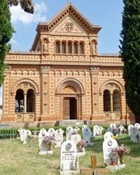
Palazzine Biscarini (1894)
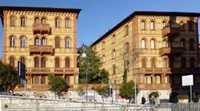
These two palaces stand on the site of the Politeama Calderini (1871), an enormous structure that Guglielmo Calderini designed to house public spectacles on a site liberated by the demolition of the southern stronghold of Rocca Paolina. Unfortunately, it had to be pulled down almost immediately due to structural problems.
Nazareno Biscarini built the twin palaces known as the Palazzine Biscarini on the site and decorated them in in terracotta from the Fornace Angeletti-Biscarini. They were renovated in 1940, when their original balconies and their mythological statues were removed. [These are now in the Frontone gardens]
Sant’ Andrea (19th century)
Angelo Biscarini (1877-1951)
As noted above, Angelo Biscarini re-opened the studio of his uncle, Francesco Biscarini in 1914. Most of his surviving works in Perugia are in the civic cemetery.
Tombs by Angelo Biscarini (early 20th century)
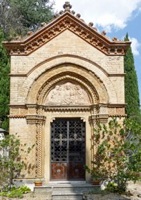
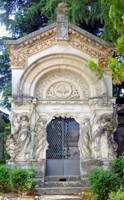
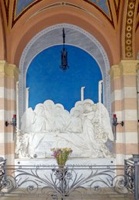
Cappella Doneddu (1907) Cappella Radicioni (1909) Tomba Mammalucchi (1912)
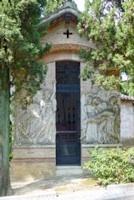
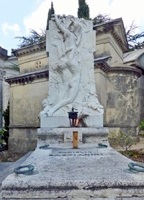
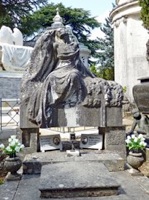
Cappella Buon-Tromboni (1926) Tomba Bastianini (1927) Tomba Misuri-Benda (1938)
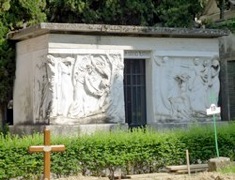
Tomba Teatini (1935-8)
The monuments in the Cimitero Civico (cemetery) commissioned from Angelo Bisacrini in the early 20th century are also described in a guide to the cemetery referenced on the page devoted to it. They included the seven illustrated above.
Return to Art in: Perugia.


